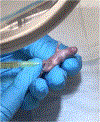Exploring Clinically-Relevant Experimental Models of Neonatal Shock and Necrotizing Enterocolitis
- PMID: 31977960
- PMCID: PMC7376956
- DOI: 10.1097/SHK.0000000000001507
Exploring Clinically-Relevant Experimental Models of Neonatal Shock and Necrotizing Enterocolitis
Abstract
Neonatal shock and necrotizing enterocolitis (NEC) are leading causes of morbidity and mortality in premature infants. NEC is a life-threatening gastrointestinal illness, the precise etiology of which is not well understood, but is characterized by an immaturity of the intestinal barrier, altered function of the adaptive immune system, and intestinal dysbiosis. The complexities of NEC and shock in the neonatal population necessitate relevant clinical modeling using newborn animals that mimic the disease in human neonates to better elucidate the pathogenesis and provide an opportunity for the discovery of potential therapeutics. A wide variety of animal species-including rats, mice, piglets, and primates-have been used in developing experimental models of neonatal diseases such as NEC and shock. This review aims to highlight the immunologic differences in neonates compared with adults and provide an assessment of the advantages and drawbacks of established animal models of both NEC and shock using enteral or intraperitoneal induction of bacterial pathogens. The selection of a model has benefits unique to each type of animal species and provides individual opportunities for the development of targeted therapies. This review discusses the clinical and physiologic relevance of animal models and the insight they contribute to the complexities of the specific neonatal diseases: NEC and shock.
Figures


References
-
- Martin GS, Mannino DM, Moss M. The effect of age on the development and outcome of adult sepsis. Crit Care Med 34(1):15–21, 2006. - PubMed
-
- Giannoni E, Agyeman PKA, Stocker M, Posfay-Barbe KM, Heininger U, Spycher BD, Bernhard-Stirnemann S, Niederer-Loher A, Kahlert CR, Donas A, et al. Neonatal sepsis of early onset, and hospital-acquired and community-acquired late onset: a prospective population-based cohort study. J Pediatr 201:106–114.e4, 2018. - PubMed
Publication types
MeSH terms
Grants and funding
LinkOut - more resources
Full Text Sources
Medical

